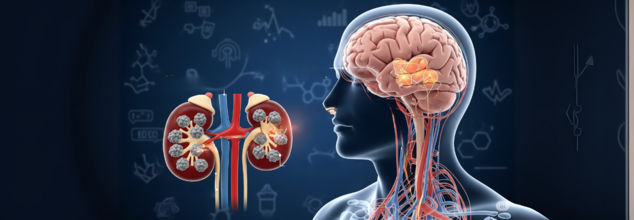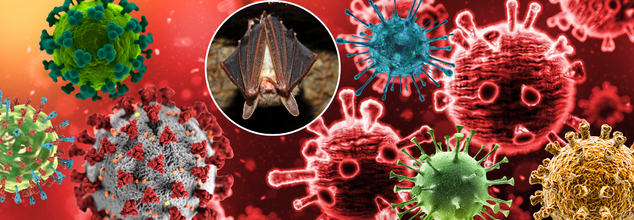- Health Conditions A-Z
- Health & Wellness
- Nutrition
- Fitness
- Health News
- Ayurveda
- Videos
- Medicine A-Z
- Parenting
- Web Stories
Optical Illusion: What You See First Reveals If You Are Detail-Oriented Or Big-Picture Thinker

Optical illusion
Optical illusions captivate our minds, challenging our perceptions and revealing fascinating insights about how we process information. The specific illusion depicted in the image features a charming village scene, where our brain interprets the intricate details of the architecture and landscape.

This visual puzzle draws attention to the right hemisphere of the brain, responsible for holistic thought, creativity, and intuition.
As you gaze at the image, notice how your brain fills in the gaps, constructing a narrative from the visual cues. This reveals not just how we perceive space and depth, but also aspects of our personality.
For instance, those who focus on details may possess analytical traits, while individuals who see the bigger picture often exhibit more creative thinking.
Moreover, optical illusions highlight our cognitive biases, which influence how we interpret reality. Engaging with such illusions can sharpen our observational skills and enhance our ability to think critically.
So, the next time you encounter an optical illusion, consider it not just a visual trick but a window into the complexities of your mind and personality!
Not From The Brain, Scientists Trace Parkinson’s Disease To This Organ In Your Body

Credits: Health and me
For decades, Parkinson's disease has long been thought of as a brain disorder, characterized by the degeneration of dopamine-producing neurons in the substantia nigra — a region of the brain that regulates movement. The loss of these neurons progressively contributes to hallmark symptoms such as tremors, rigidity, and decreased movement. But groundbreaking new research appearing in the journal Nature Neuroscience is refuting that long-standing assumption. The roots of Parkinson's may not be in the brain at all, according to scientists from Wuhan University in China — they could be in the kidneys.
The new study, by a Wuhan University team in China, focuses on alpha-synuclein (α-Syn), a protein intimately associated with Parkinson's. Under normal conditions, α-Syn is involved in healthy neural function. But when it misfolds and aggregates, it becomes toxic and clumps together into Lewy bodies—Parkinson's and other related disease hallmarks.
This unexpected finding is based on an increasing amount of evidence that Parkinson's could start in peripheral organs and spread to the brain, as opposed to starting in the brain itself. The potential ramifications for early treatment, prevention, and detection are staggering.
According to the authors of the study, "We show that the kidney is a peripheral organ that is an origin of pathological α-Syn." Central to this research is a protein called alpha-synuclein (α-Syn) — already far and away with links to Parkinson's disease and other neurological disorders. In health, this protein is used in neuron function. But when it goes awry, it forms sticky clumps known as Lewy bodies, which disrupt brain function and are a hallmark of Parkinson's and dementia with Lewy bodies.
To reach their conclusion, the team performed a succession of very careful experiments. They studied kidney samples from individuals with Parkinson's and associated Lewy body dementias, as well as patients with chronic kidney disease (CKD) with no neurological symptoms. The results were dramatic: abnormal α-Syn growth was identified in the kidneys of 10 out of 11 individuals with Parkinson's or Lewy body dementia, and in 17 out of 20 CKD patients—even though these CKD patients had no evidence of disease in the brain during life.
What they discovered was astounding: Abnormal α-Syn deposits were found in 10 out of 11 Parkinson's or related disorder patients. But even more astonishing, 17 out of 20 CKD patients — with no known brain disorder — also exhibited early evidence of the same misfolded proteins in their kidneys.
This implies that protein clumping could start in the kidneys, many years before symptoms of neurological harm become evident. Traces of α-Syn pathology were also detected in regions of the brainstem and spinal cord in a few instances, again favoring the hypothesis of a kidney-to-brain route.
How Do the Kidneys Affect Parkinson's Risk?
The kidneys are not passive waste filters; they also actively remove α-Syn from the bloodstream. When kidney function is impaired, as in chronic kidney disease, this elimination process is defeated. The consequence is the accumulation of toxic proteins within the kidneys, which migrate to the brain and ultimately trigger the damage cascade causing Parkinson's.
This shift in paradigm is strengthened by epidemiological data. Massive research has revealed that individuals with compromised kidney function are at considerably greater risk of getting Parkinson's disease. The correlation is nonlinear, with increasing steepness in the risk as kidney function worsens.
Are There Multiple Triggers for Parkinson's?
This link between kidneys and brain doesn't imply the brain isn't involved in Parkinson's, but it doesn't exclude other causes either. Indeed, past studies have indicated that the gut might also be a place where α-Syn is accumulated and transmitted to the brain early on. The new research indicates Parkinson's could be a multi-system disorder, initiated by a range of causes and mechanisms—such as the kidneys, the gut, and possibly even the heart.
As the authors of the study point out, "Removal of α-Syn from the blood may hinder the progression of Parkinson's disease, providing new strategies for therapeutic management of Lewy body diseases."
Implications for Diagnosis and Treatment
The revelation that the kidneys could have a central role in Parkinson's offers both new hope for early detection and intervention. If α-Syn accumulation in the kidneys can be identified before neurological signs are apparent, it might be an early warning sign, enabling the possibility of preventive measures or early treatment.
In addition, treatments to enhance kidney function or facilitate clearance of α-Syn from the bloodstream may prove to be useful weapons in the battle against Parkinson's and other disorders. This strategy would complement current methods, which target preservation of the brain's dopamine-neurons.
Although the research is revolutionary, it isn't without its constraints. The human tissue sample was quite small, and though mice work well as models for human biology, they are not replicas.
Even so, the evidence is compelling enough to support more research. Subsequent studies with bigger human populations, improved imaging technology, and more comprehensive genetic analysis could replicate and build on these findings.
If confirmed, the kidney-brain link might be the missing piece of the Parkinson's puzzle — setting the stage for earlier diagnosis, tailored treatments, and even preventive medicine aimed at flushing out or blocking α-Syn in the kidneys and blood.
The kidneys could be a silent trigger for Parkinson's disease, with poisonous protein accumulation moving from the kidneys into the brain. Keeping kidneys healthy might be the key in the battle against neurodegenerative disorders.
Jenny Mollen Ends Up In ER After Microdosing GLP1 Medication

Credits: Instagram and Canva
US TV Star, the 46-year-old Jenny Mollen was rushed to the Emergency Room due to a reaction that happened after she consumed the weight-loss drug, GLP1 or the glucagon-like peptide-1 medication.
In an Instagram story on June 26, she wrote, “I just posted a follow-up to my piece about Tirzepatide and microdosing. I had a lot of unanswered questions about it [that] just ironically got answered for me in the form of a trip to the ER two nights ago … I’m in such a f***ing haze. It’s been a crazy 48 hours.”
She also revealed that she lost one-fourth of her blood as she ended up in the hospital.
What Is Tirzepatide?
Before we understand what is tirzepatide, it is important to understand how GLP1 medications work. It is a hormone naturally produced in the body that plays a role in regulating blood sugar levels and appetite. GLP-1 receptor agonists are a class of medications that mimic the effects of this hormone, used to treat type 2 diabetes and, increasingly, for weight management.
Tirzepatide, on the other hand is a GLP1, like Ozempic or Wegovy. It regulates a person's blood sugar, appetite, and digestion. These medications are usually used to treat type 2 diabetes and obesity.
What Happened To Mollen?
Mollen, who is the wife of Jason Biggs, also wrote an essay, published on Substack, where she expressed her "growing concerns" about how the medication was affecting her “mentally.”
In her essay, she wrote: “I do think that in the coming years, we will hear more about how GLP1s cause depression, ruin marriages and rob us of our capacity for feeling joy. These drugs bind to our neurotransmitters, affecting levels of dopamine and serotonin. They change our relationship with food. And I believe they also change our relationship with people and ourselves.”
She also noted that why others may have a desire to use it, however, she expressed her concerns over how it could have a negative impact on individual’s mental health, as she also has her own first-hand experience.
She further noted: “When I started Tirzepatide, the first thing I noticed was that I was crying more frequently. I couldn’t control the tears that would pour out of me when talking about subjects ranging from kids to open-faced tuna melts. I also noticed this underlying anxiety that would, without warning, after no more than one cup of espresso, take over my body and have me pacing in the kitchen like I’d just snorted an eightball of cocaine.”
She also noted that she would get irritated much quickly and she was “more easily offended and quicker to react” while she was on GLP1.
She wrote: “I also began to sense that the joy and gratitude I once experienced, those moments of peak happiness, weren’t quite as intense as they used to be. I could feel the joy simmering beneath the surface, but it never reached the pinnacle it once had internally. Even on a rollercoaster, my sense of euphoria was dampened. I couldn’t feel the highs and lows. Satisfaction, personally and professionally, was just out of reach.”
Scientists Find Over 20 New Bat Viruses In China, Warn Of “Critical Implications”

The most deadly viruses in the world may be quietly fermenting in fruit orchards—literally over your head? You got it. In a finding that is generating high-profile buzz throughout the international scientific community, scientists in China have discovered over 20 novel bat viruses, some of which have close relatives to Hendra and Nipah—diseases with skull-chilling mortality rates and a track record of crossing over from animals to humans.
So what does this all mean to you, me, and the rest of the world? A new science study issued a warning to the global health community: scientists have found over 20 previously unknown viruses in Chinese Yunnan province bats. Two newly discovered henipaviruses closely related to the lethal Hendra and Nipah viruses are causing special concern because of their likely ability to cause human and animal disease. Health professionals caution that these discoveries have "critical implications" for global public health, highlighting an urgent need for increased surveillance and biosecurity protocols.
The discovery, reported in the journal PLOS Pathogens, has been sending shockwaves across the world's scientific and medical circles, with scientists alerting that the newly discovered viruses may have "critical implications" for global public health.
The Two Viruses That Have Experts Particularly on Edge
Two of the 22 viruses identified were particularly concerning: henipaviruses—a class of viruses with a reputation for being lethal. These were discovered in fruit bats that inhabit the vicinity of orchards and human habitations, a configuration that duplicates earlier outbreaks of Hendra virus in Australia. Among the viruses discovered in the study is the closest-known relative of the Hendra and Nipah viruses, which carry mortality rates of 40% to 80% in humans and are responsible for causing severe respiratory disease and brain inflammation.
What is more alarming is the transmission mode: both Hendra and Nipah viruses can also be transmitted via bat urine. In farming areas where bats scavenge in fruit farms, infected fruit can be used as a bridge for spillover into livestock—or humans.
"Academically, this is not a concern," replied Associate Professor Vinod Balasubramaniam, a virologist at Monash University's Malaysian campus. "This has practical implications, particularly for nations such as Australia where the ecology is shockingly similar."
Why Bats Are A Matter of Concern?
Bats have long been known to be the main hosts of viruses that are able to leap onto humans and animals, sometimes with catastrophic consequences. From Ebola to SARS, MERS, and most recently, the coronavirus causing COVID-19, bats are often suspected to be responsible for the appearance of new infectious diseases. Their own biology—long lifespan, social roosting habits, and strong immune systems—tends to make them perfect reservoirs for a vast range of viruses.
The emphasis of the new study on the kidneys is important. While most research to date has focused on bat saliva, feces, or blood, the kidneys might be important in viral shedding, especially by way of urine. This is particularly important for henipaviruses, which have been found to be excreted in bat urine and can infect fruit or surfaces and cause spillover to humans and animals.
The Henipavirus Threat
Of all the viruses that have been found, the two new henipaviruses in fruit bats are of most concern to researchers. One of them is now known to be the closest-known relative of the Hendra and Nipah viruses—both of which have caused fatal outbreaks among humans and animals.
Hendra and Nipah viruses have the notorious reputation for high mortality rates, ranging from 40% to 80%. They induce severe brain inflammation (encephalitis) and respiratory illness, and can spread efficiently within populations of both humans and animals. In Australia alone, Hendra virus has caused 66 recorded outbreaks since 1994, killing four individuals and scores of horses. Nipah virus, on the other hand, has produced recurrent outbreaks in South and Southeast Asia, frequently associated with the consumption of fruit or fruit products contaminated by urine from bats.
The detection of henipaviruses closely related to each other in Yunnan's fruit bats—particularly those that inhabit orchards and villages—heightens the possibility of future spillover incidents. As Associate Professor Vinod Balasubramaniam of the Malaysian campus of Monash University points out, "The proximity between the Australian rural setting and Yunnan's orchards close to human dwellings emphasizes the need for heightened surveillance and biosecurity efforts."
How Do These Viruses Spread?
Bats have come under closer scientific examination as natural reservoirs for most lethal viruses, including SARS, MERS, Ebola, and even SARS-CoV-2. This research is special because it targets the kidneys—a less often examined organ in virology studies.
Both Hendra and Nipah viruses can be spread by contact with bat urine. Fruit bats in agricultural environments tend to roost and feed in orchards near human habitation. When their urine gets onto fruit, the virus is consumed by livestock or human beings, paving the way for possible outbreaks.
This method of transmission is especially cause for alarm in areas where humans and animals are in close contact to bat habitats. As Dr. Alison Peel, a disease ecologist of wildlife at the University of Sydney, describes, these results indicate "potential opportunities for contact" with humans—particularly those in rural and peri-urban settings.
This research broadens our knowledge of the bat kidney infectome," scientists said. "It identifies the imperative zoonotic dangers lurking in plain sight and emphasizes the importance of complete-spectrum viral monitoring in understudied organs.
As per Dr. Yong Gao Peng, a virologist who participated in the research, "This finding does not mean an outbreak will be imminent. But it does show just how much we still don't know about the viral world within bats, and how important it is to chart it out comprehensively."
Why the World Should Pay Attention?
The detection of so many new bat viruses in a fairly small sample puts into perspective how much scientists actually still have yet to learn about the microbial universe borne by bats. As Dr. Yong Gao Peng, a virologist at Nias, cautions, "While the results are based on bat kidney samples and do not suggest impending outbreaks, they show how much we still don't know about the microbes bats carry."
In light of the past history of lethal outbreaks with bat-borne viruses, the stakes are obvious. Increased monitoring, particularly where bats and humans coexist in close proximity, is called for. The research also underscores the necessity of thorough investigations of hitherto less-studied organs—such as the kidneys—to fully evaluate the entire range of spillover threats.
"These viruses don't have to be pathogenic today," added Dr. Peel, "because viruses change. The take-home message here is the need for urgency in surveillance, especially in ecotones where humans, animals, and wildlife overlap."
Dr. Peng further contributes that the existence of such viruses, while localized to kidneys in this instance, is a sign from nature. "Most outbreaks are initiated by asymptomatic spillovers," he states. "Without timely detection and proper containment measures, they could quietly ferment into international crises."
This finding arrives as the globe is still fighting COVID-19 and wrestling with the advent of new infectious variants. Only 6% of Australian adults have been vaccinated with the new COVID-19 booster, as reported in national health figures. With the northern hemisphere preparing to face another winter surge, public health officials say complacency is not a choice.
© 2024 Bennett, Coleman & Company Limited

